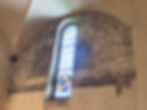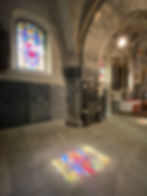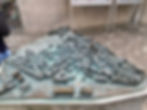First time visiting Chur, the oldest town in Switzerland
- Deborah Kade
- Sep 6, 2022
- 11 min read
Today was a very loooooong day! Since Michael and I have never been to Chur, I decided we should visit. Unfortunately, it is almost a three and a half train ride each way.
I wanted to light candles at the Cathedral of St. Mary of the Assumption.


We took the new regional train, the Bärnrocket, to Spiez. We were to get off on track 2 and just cross over to track three. Since the German ICE train which originated somewhere in Germany was 20 minutes late, it interrupted the times and tracks, so we now had one minute instead of three to hustle and go underneath two tracks over. We hopped on as the conductor blew his whistle.. In Spiez, we boarded an EC, Euro City, to Bern. I’m assuming the starting point for this train was somewhere in Italy, possibly Milan, as many trains coming from Brig start in Italy. Changed trains in Bern to one going to the Zurich main train station.
At the larger cities, they have a free paper called the "20 minuten". It takes about 20 minutes to read through hence the name. If you are in the French section, the newspaper is written in French, German for the German section, and Italian in the Italian section. Michael does receive the daily German edition on the Internet. It is a way for him to keep up with his German.

There is even an article about E- Autos. What they are trying to say is there isn't enough electricity in California to charge all the electric cars and you can only charge during certain hours. It is nice for Gavin Newsom to tell people no more gas cars will be sold in California after 2035. Has he thought about the infrastructure it will take to change to electric vehicles? No new electric plants have been constructed in California for over 30 years so that results in California having to buy electricity from outside the state. It is nice to come up with a policy but you have to have solutions from the start to the finish. Look at the amount of states like Massachusetts and Virginia that are now tied to California policies. The government is not going to put in charging stations. How will electricity be produced? Nuclear, wind, solar, water, gas, oil....? Then, there is the problem with the batteries in the car. You need rare earth minerals, cobalt and lithium, to make the batteries. Where does one get these? At least Elon Musk was smart enough to put in charging stations all over the US and Europe. As a Tesla owner I'm not happy if all other makes of electric cars can charge off a Tesla station. As a stock holder, my shares will be worth more. Changed trains at the Zürich main train stationfor one going to Chur.

It is helpful to have the SBB train app so we know which track we will arrive at and from which track we will leave. The app also tells you how long you have to go from one track to another.
The trip to Chur takes us partially along the lake of Zürich. Then, we pass along lots of rolling hills with high mountains off in the distance. We pass the Lindt and Sprüngli chocolate factory as well as another one. The train travels along areas dedicated to farming with miles and miles of corn and grass. The cows here are mostly brown and not the black and white cows like you see in the area of Gruyères.

Surprised when we were near Landquart I could see vineyards at the base of the mountains. I learned the city of Chur is surrounded by fertile countryside, the Chur Rhine Valley. The young Alpine Rhine, wine-growing areas and a diverse natural backdrop characterize the region around Chur's neighboring communities.

The closer we get to Chur, the more mountainous it gets. We go through many tunnels through the mountains.

The only wind turbine I have seen during our visit.

Arriving in Chur

This specialty walnut tart was brought to Graubünden by local confectioners from the southern regions where walnuts are grown. Today it is a common souvenir from Graubünden.
Bündner Nusstorte

I believe it is a pear bread. I will ask Michael in the morning. He is asleep.


Chur is the capital and largest town of the Swiss Canton of the Grisons and lies in the Grisonian Rhine Valley, where the Rhine turns towards the north, in the northern part of the canton. The city, which is located on the right bank of the Rhine, is reputedly the oldest town of Switzerland.
Archaeological evidence of settlement at the site, in the Eastern Alps, goes back as far as the Pfyn culture (3900-3500 BC), making Chur one of the oldest settlements in Switzerland. Remains and objects from the Bronze and Iron Ages have also been found in the eastern sector of the current city's center. These include Bronze Age Unfield and Laugen-Melun settlements from 1300 to 800 BC and Iron Age settlements from the 5th to 3rd centuries BC. The Roman Empire conquered the area that then came to be known as the Roman province of Raetia in 15 BC. Under emperor Diocletian late 3rd century AD, the existing settlement of Curia Raetorum (later Chur) was made the capital of the newly established province of Raetia prima. In the 4th century, Chur became the seat of the First Christian bishopric north of the Alps. Despite a legend assigning its foundation to an alleged Briton king, St. Lucius, the first known bishop is one Asinio in AD 451. The bishop soon acquired great temporal powers, especially after his dominions were made, in 831, dependent on the Empire alone. Chur has a population of 36,336.
"Chur is home to many buildings or other sites that are listed as Swiss heritage sites of national significance. There are two archeological sites in Chur, the old city which is a medieval city and Welschdörfli a prehistoric settlement and Roman Vicus. There are four archives or libraries; the bishop's palace (library and archive), the Cantonal Library, the Cantonal Archive of Graubünden and the city archive of Chur. There are also four museums on the list; the Bündner Kunstmuseum (Art Museum), Bündner Naturmuseum (Natural History Museum), the Dommuseum and the Rätisches Museum in the Haus Buol. Three churches are included in the list; The cathedral of the Assumption, the Catholic Church of St. Luzi and the Reformed church of St. Martin."
The first church on the cathedral site was built in the first half of the 5th century. The Romanesque crypt was probably built under Bishop Tello (758-73). It contains remarkable paintings by Albrecht Dürer and Hans Holbein. The current building was built between 1154 and 1270. In 1272 it was dedicated to Saint Mary of the Assumption. The round arch window along the center axis is the largest medieval window in Graubünden. The late-Gothic high altar was completed in 1492 by Jakob Russ.
The Church of St. Luzi was probably built in the 8th century, though the first record of it appears in 821 when the relics of St. Luzius were removed from the church. It may have been the site of a Carolingian scribes' school during the early Middle Ages. In 1149, it became the church of the Premonstratensian monastery.
There are 15 other buildings that are also heritage sites; these include the Alte Kaserne at Zeughaus 3 (the Old Armory), the Confederation Paper Mill, the Main Post Office, the new Town Hall, headquarters of the Rhätische Bahn and several old patrician houses. With the 2021 merger of Haldenstein into Chur, the Ruins of Haldenstein fortress and Haldenstein Castle became part of Chur.
The town is home to the Giger Bar designed by the Swiss artist H.R.Giger, the Old Town, the art gallery, and the natural history museum. There are many cultural and culinary amenities of this Alpine town! Especially worthy of note are the Bishop's Palace and the triple-naved cathedral of Sankt Maria Himmelfahrt. Whether you're after cathedral treasure, Giacometti, biodiversity or souvenirs, Graubünden's capital, with its three regional museums and over 500 shops, offers something to do in any weather. Chur has one of the best preserved Old Towns in Switzerland. Over the past 20 years it has been renovated continuously and is now free of traffic. Red signs direct the visitor to the most beautiful sights, squares and alleys. The Old Town often forms the backdrop for colorful markets – for example, every Saturday morning from May to October there is the weekly market (farmers' market) while the Christmas market is held at the end of the year. With parking in the immediate vicinity and numerous cozy cafés, the Old Town with its winding alleys provides a wonderful ambience for a leisurely shopping stroll around the many boutiques and shops.


I like this bench. You can change the direction of the back by moving the lever on the side.









Symbol of Chur

Interesting art sculptures around the city.



The time flies away


I wished the rodents would fly away.


"The Rhaetian Railway Administrative Building is describes as a large and gray, yet friendly - that sums up the building constructed by St. Moritz architect Nicolaus Hartmann between 1907 and 1910. While these gray, starkly structured façades give the building a majestic appearance, thanks to its large forecourt it is overpowering. The architecture is an expression of the so called "Bundner Heimatstil", a movement that took up and developed the traditional style of building of the region. This building is regarded as one of the movement's most significant works."



The Rathaus - city hall

Oriel Windows - only wealthy people could afford oriel windows.

Not as many fountains as there are in other cities




Since it is a very long train trip each way, we concentrated on the Old Town section. I know we only scratched the surface, though. Now, we have reason to return. I especially wanted to see the Cathedral of St. Mary of the Assumption." The fortifications surrounding the cathedral make it look like a miniature town, high above the city. The Romanesque Cathedral was finally completed in 1272 after a construction period lasting over a century. Built around it are the Episcopal Palace and the canons' houses, which progress down towards the city and finish up bordering onto a tower. This tower still houses a late Gothic drinking parlor from the 16th century."






















Late Gothic winged altar by Jakob Russ from Ravensburg (1492)
Restored 2001-2002




I lit many candles. I had my own row of candles. Prayers for family and friends.






Sacred heart of Jesus










"In the shadow of St. Martin Church is a row of houses of considerable historical significance. Situated on Martinplatz, Haus Reydt, with its three story oriel, was built in 1574 in the late Gothic style. Next door is even older Antistitium, whose neighboring building contains important paintings from 1580. This depicts, in a comical reversal of reality, rabbits chasing a hunter. The Zunfthaus was rebuilt following the city fire in 1464."




"Back in the 18th century, Fontana Park was a resplendent sight, with its exotic shrubs and plants, elaborate fountains, and heated greenhouses. However, in those days it was a private pleasure garden. In 1727, diplomat Peter von Salis-Soglio built a house, the Altes Gebäu, together with a large garden at Poststrasse. The present day name of the park, which was redesigned in 2006, alludes to Benedikt Fontana, who died a hero's death in the Battle of Calven in 1499 during the Swabian War. A monument by sculptor Richard Kissling, created in 1903, is dedicated to Graubünden's version of William Tell.”








While touring I always pay attention to chimneys.

Yes, I would really enjoy having this much whipped cream on top of my hot chocolate!!! Would you like this much cream for your coffee?? I can name two people who would love this.

“The Bärenloch, or “bear hole” is one of the most enchanted places in the city of Chur- and at the same time one of the best preserved parts of the Old Town. The origin of this name, given to the two interior courtyards between Arcas Platz and Kirchgasse, is unknown- yet it is an appropriate description all the same. However, in ancient documents the dark Bärenloch is referred to as “curschellas”, a late Latin term simply meaning “small courtyard rooms”. Indeed, the two rooms still seem small and cramped to this day, thus making the Bärenloch a good example of the living situation in late Medieval Chur.”




interesting water spout

Switzerland is old but very clean







“The St. Martin square lies in the oldest part of Chur, midway between the two towers, the Obertor and the Untertor, thus forming part of the historical north- south route through the inner city.It is dominated by the Kirche St.Martin. Graubünden’s largest late Gothic church was built following the city fire in 1464 using parts of the previous Carolingian building. An attractive feature is the three stained glass windows painted by Augusto Giacometti in 1919. The Martinsbrunnen dates from 1716. It’s basin is adorned with signs of the zodiac. Apart from the sign-holder and the columns, the fountain is still in its original state.”






Inside St Martin








This braille relief is in front of St. Martin Church.

“The PostPlatz is a hub of everyday life in Chur, for two important axes cross here. With its large department stores, Bahnhofstrasse, which continues into the Old Town as Poststrasse, constitutes the busiest shopping promenade in Chur. Grabe Straße, which today leads the traffic around the outskirts of the Old Town, is historically also a "strolling mile". Grabe Straße was designed as a typical 19th century boulevard- wide and impressive. Today it also marks the site where the former city walls once stood."





The cantonal building

The door knocker is quite weathered

"Picturesque and medieval is how the Arcas looks today. Before 1971, it was quite a different story, for until then warehouses obscured the square. Architect Theodor Hartmann had these demolished and integrated an underground garage into his new design concept. Nevertheless, the Arcas has still retained its medieval character, for the row of houses extending toward the Plessur River are built onto the old city walls. At Arcas 25, the houses are thought to date from the 13th century. Nowadays, the medieval houses, with the modern open spaces in between, give the square a picturesque touch."




Could her name be Ruby?










Outdoor chess is very popular throughout Switzerland.



time




temperature

We stopped along the Postplatz at the Restaurant Rätushof for an early dinner as we knew we wouldn't find another place to eat before our long train trip back to Unterseen. Most restaurants are open for lunch and then the kitchen closes at 2 PM and doesn't open again until 6 PM or 7 PM. This restaurant served food from 11:30 until closing. If we eat too late, we both have trouble sleeping. We both had the Buure Rösti. I would have to say Rösti is a traditional Swiss dish. It is hash browns with some topping or toppings - different types of cheese from different regions of the country, sausages, bacon, apples, onions, fried egg, etc. Our Buure Rösti had bacon, small veal sausages and a fried egg. It came on a sizzling hot pan. The hash browns were soft, tender, and almost creamy in the middle while the bottom and sides were crispy crunchy.


Michael had a Kübel beer and I had a Kübel panache. This panache was a mixture of beer and Sprite which was perfectly proportioned. I usually save a last bite or sip from what I liked most about the meal and today I chose the panache. As it was a little humid, water is necessary.

Trains were crowded leaving both the train stations in Chur and Zürich. It started raining once we left Chur but only lasted a about 10 minutes. Michael tried to capture a rainbow, but it was difficult because of the reflection in the window.

On the way back to Unterseen, we switched trains again in Bern. The ICE German train which originated this morning in Berlin was to be our train. You know us and the German trains. Jinxed! The departure board showed first class to be in sector E and F but when the train pulled in, the board quickly changed to show first class was now in sector A and B. That meant we had to walk the full length of the train. Of course, as our luck would have it, the conductor announced we would be 10 minutes late leaving Bern. We are in the quiet zone car so I can't even voice my disappointment out loud.
It was a loooooong day but a fun day exploring a new city! We will be back someday.
